JICA Chugoku Training Program Division interviewed eight participants who came from countries around the world to know their country and their life in Japan. They have stayed in Japan more than 2 years and successfully graduated a university in japan on March 2020.
We would like to share interesting stories from them with you.
In this page, we introduce you about their country culture and life in Japan.
Traditional wear of;
- King of Tonga (Ms. Tilisa TOHI)
One of our uniqueness in the Pacific is our traditional wear. The name is "Ta'ovala", a woven mat worn by Tongans as a sign of respect. - Kingdom of Lesotho (Ms. MORAI Mamotjoka Joyce)
This is my picture wearing Basotho traditional dress and Basotho hat at my friend's graduation in Kyoto
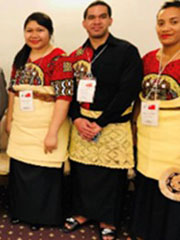
Ta'ovala
King of Tonga (Ms. Tilisa TOHI)
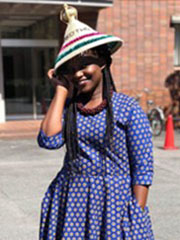
Basotho dress and hat
Kingdom of Lesotho
(Ms. MORAI Mamotjoka Joyce)
Traditional food of;
- Republic of Vanuatu (Mr. WONG Alexander)
Each islands have their own traditional dishes. I come from Tanna island in the southern part of the country. just to name a few which I like are Nallot, Laplap, SImboro, Punya etc. - King of Tonga (Ms. Tilisa TOHI)
Raw fish is one of our traditional dishes but we prepared it differently from Japan, we add coconut milk with sliced tomatoes and green onions together with the raw fish (we called it ‘ota ika" meaning eating raw fish, just like on the photo below. We also have roast pig as our famous traditional dishes, and we eat both ota ika and roast pig with yams, breadfruit, green banana and different types of root crops as our staple food. We only prepared a roasted pork on special occasions such as weddings, birthdays, coronations, church and graduation ceremonies. - Kingdom of Lesotho (Ms. MORAI Mamotjoka Joyce)
Lesotho food yellow corn (Papa), green vegetables (Moroho), and chicken stew I prepared for my friends in Japan. - Republic of Senegal (Mr. CISS Mamadou)
Mafé is made with rice and peanut butter sauce with meat (beef, veal, lamb, chicken or fish).
Domada is made with a kind of stew flour sauce which can be mixed with meat or fish.
Tiébou ganar is made with rice mixed with or without tomato and fried chicken.
Tiébou yapp as well is made with rice with or without tomato and meat (beef, veal or lamb).
Tiébou djieun is made with rice with or without tomato and fish (it can be any kind of fish).
Senegal has a custom of enjoying tea. The Senegalese tea is called Ataya. Ataya is three-cup tea ritual, using green tea, fresh mint, and of course, sugar. Each cup symbolizes life and friendship. The first one is bitter. The second one is sweet. The third one is super sweet. Ataya is a conversation starter and typically served after meals. Tea slurping keeps the conversation party going.
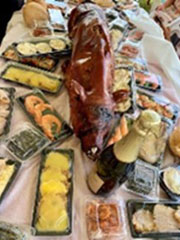
Roasted pork
King of Tonga (Ms. Tilisa TOHI)
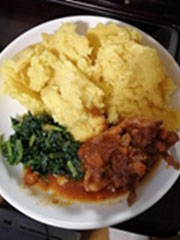
Yellow corn (Papa), green vegetables (Moroho), and chicken stew
Kingdom of Lesotho
(Ms. MORAI Mamotjoka Joyce)
University life in Japan
Ms. Tilisa TOHI who graduated from Okayama University said
"I was a student at the Institute of Plant Science and Resources which is a part of newly established Okayama University graduate school of Environmental and Life Science. It runs various graduate programs at Master (MSc) and Doctoral (PhD) levels that are associated with the research staff and laboratories located at Kurashiki campus. It was a great experience because I gained a lot of skills from working together with research staffs and Professors. The knowledge obtained are beyond of an ordinary university student. Although it was a hard work and needed a lot of efforts plus their syllabus was very intense, but in the end I know its benefits. "
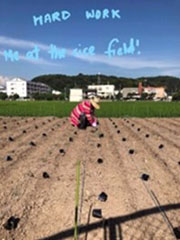
Ms. Tilisa TOHI
Okayama University
Favorite Japanese food of participants
- 1 . Sushi
- 2 . Hiroshima style Okonomiyaki
- 3 . Japanese curry & rice
- 4 . Udon noodles
Favorite Japanese culture of Participants
Bowing for greeting, Hanami (Million-dollar view of cherry blossoms /sakura), Tea ceremony, and Yearly festivals being performed across Japan.
Mr. WONG Alexander said
"At the Handayama Botanical Garden in Okayama, I enjoyed beauty of Sakura."
"I love to watch the yearly festivals being performed across Japan. For example the culture shows in November I believe and others on the street which is called "Mikoshi". Mikoshi is a really impressive event. "
Ms. Tilisa TOHI said
"I loved how they don't shake hands or hugs but bow. In my home country, you only bow to the King and Queen, the highest rank in the society. Here in Japan you can bow to anyone and people can bow to you too which is quite impressive to me. "
Mr. SINABAJIJE Alphonse said
"I like seeing people bowing while they are greeting each other, I wanted to give a handshake but people were not interested."
Mr. UKWIZAGIRA Emmanuel said
"I have liked Japanese culture with which flourish hard work, mutual respect, humility, safety and is considerate of foreigners and other values."
Mr. CISS Mamadou said
"I enjoyed the Saijo Sake festival because we sang Japanese song while beating drums, walking through the crowd. At night, I joined the concert and had a blast with friends. "
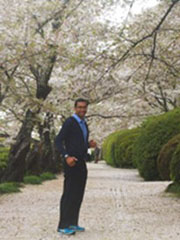
Hanami
(Mr. WONG Alexander)
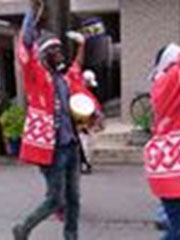
Saijo Sake Festival
(Mr. CISS Mamadou)
Favorite place in Japan of Participants
- Miyajima Island (Hiroshima prefecture)
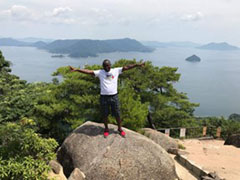
Nice View from the top of Mount Misen in Miyajima.
(Mr. SINABAJIJE Alphonse)
- Universal Studios Japan
Ms. MORAI Mamotjoka Joyce said
"I visited there in 2019 with my African and Japanese friends. I have heard people say life is a roller coaster, and I wanted the chance to see and ride the roller coaster, and I did! One thing I learned from that experience is that life is truly like riding a roller coaster; it is fun, scary and sometimes an overwhelming experience and it needs me to hold on until the end. If anything, Universal Studios Japan is a therapeutic place to be! "
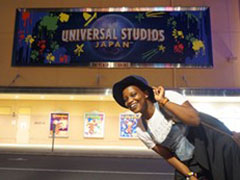
I like Universal Studios Japan.




scroll